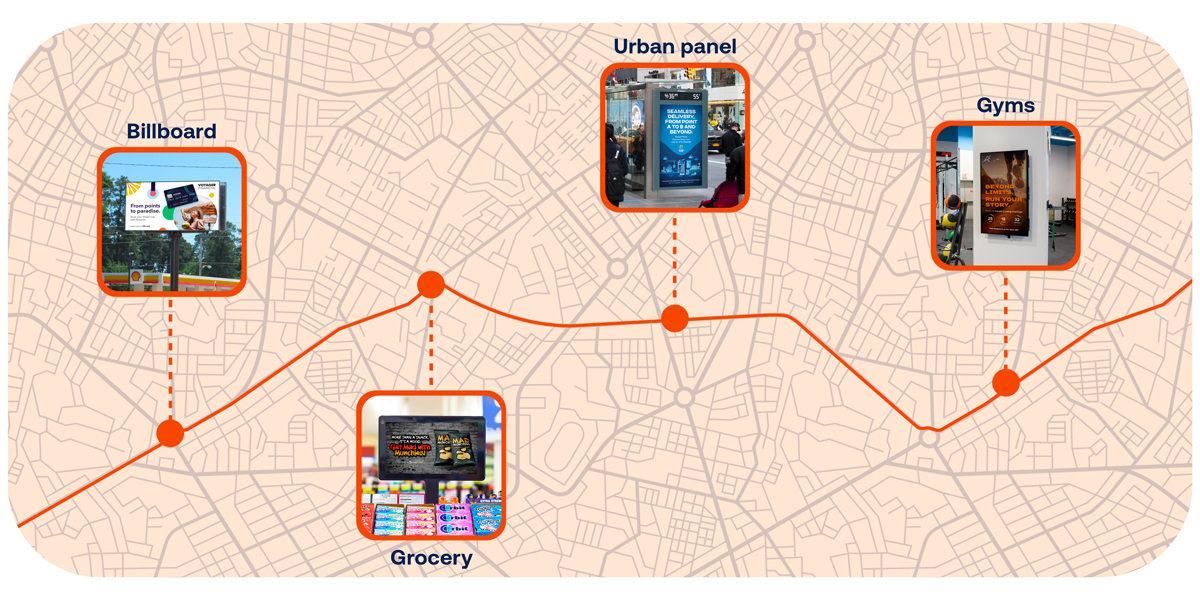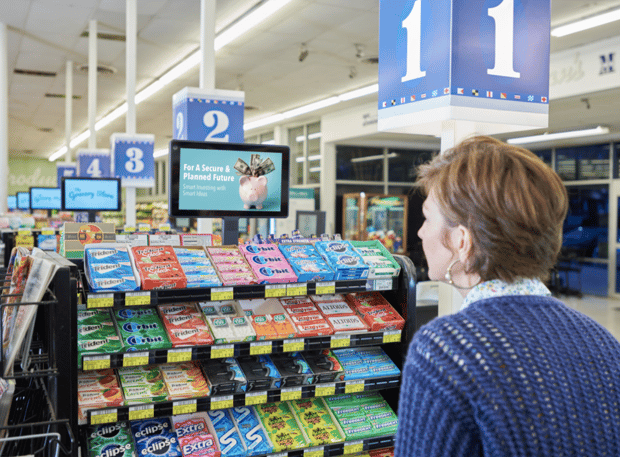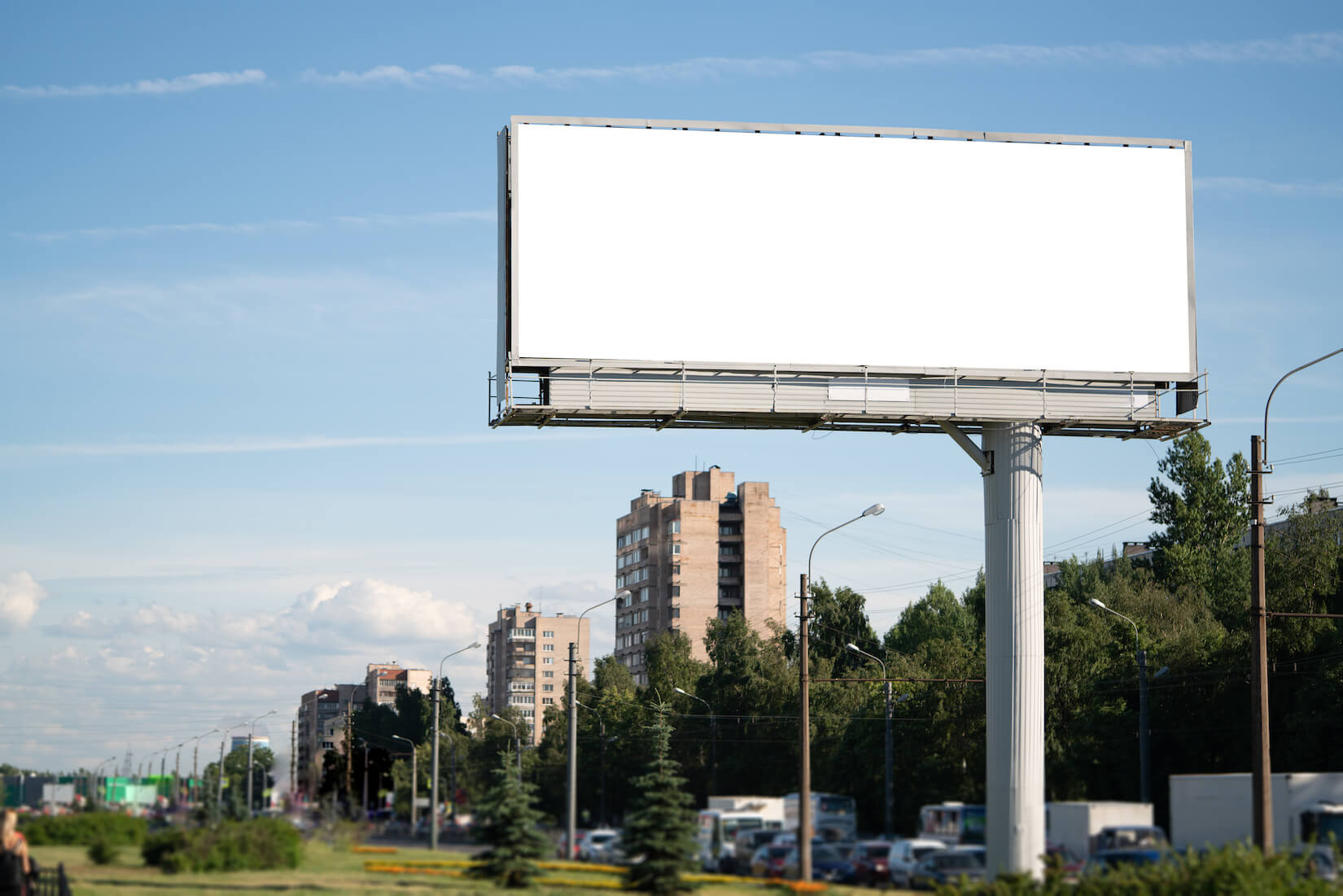
Billboards are a prime example of advertising outdoors. As an out-of-home ad format, billboards have been around since the 1830s, and since their creation, very little had changed about their operating model. However, in the past decade, we’ve seen a fundamental shift in both the technology surrounding the out-of-home (OOH) ad space and in how advertisers and media owners interact. Today, more and more digital out-of-home advertising buying and selling happens programmatically — giving rise to the future of outdoor advertising.
Programmatic DOOH advertising is the automated process of buying and selling digital out-of-home ad placements — think digital billboards, bus shelters, gas station TV, EV charging stations and many other screens consumers see as they move throughout their day.
In this article, we’ll dive deep into the world of programmatic DOOH advertising and break down the key aspects that make this technology such a powerful force for your next ad campaign.
Stats about out-of-home advertising
DOOH campaigns differ from other forms of digital advertising. As a one-to-many medium, DOOH is focused on reaching groups of people rather than tracking down specific individuals. Before we discuss why programmatic is the future, let’s first look at the effectiveness of out-of-home advertising overall using these outdoor advertising statistics:
- 50% of global audiences who have seen DOOH ads say the ads encouraged them to make a purchase "there and then."
- Since 2018, the DOOH industry has seen a 41% increase in ad spend.
- Two-thirds of global audiences said DOOH ads had encouraged them to search for more information online.
- 48% of social media users engage with pictures of OOH ads that they see in their social feeds by visiting the advertised company’s website.
- 58% are very likely or likely to believe messaging in OOH ads.
Benefits of programmatic DOOH advertising
If you’re an advertiser, programmatic DOOH advertising allows you to deliver highly targeted ads to your audience at the perfect moments as they move throughout their day.
Think about the typical movement pattern of an average consumer: they get up, get in their car, maybe stop at a gas station and drive to work. Then, after work, they drive home, go to the gym and pick up some groceries. Using programmatic DOOH advertising, you can leverage screens at each of these locations to reach this consumer at every stage of their daily journey.
 Furthermore, your messages don’t interfere with your audience’s daily lives the way a video or display ad would — they are generally seen as less obtrusive than many digital ad formats. In fact, research has shown that 88% of people enjoy seeing ads on out-of-home screens.
Furthermore, your messages don’t interfere with your audience’s daily lives the way a video or display ad would — they are generally seen as less obtrusive than many digital ad formats. In fact, research has shown that 88% of people enjoy seeing ads on out-of-home screens.
Also, because OOH in general is a one-to-many medium, DOOH ads are not susceptible to ad fraud or ad blockers and are generally not seen as “creepy” as online or mobile ads (think about the last time you mentioned a product to a friend only to see an ad for that product pop up in your Instagram feed).
In addition, programmatic DOOH ads allow you to tailor your messaging and/or shift your ads to different locations based on things like time of day, weather conditions, sports scores, etc. in real-time — enabling your brand to adapt your campaigns to changing consumer behavior and real-world circumstances.
How does programmatic DOOH advertising work?
Programmatic DOOH works just like traditional programmatic advertising. Think about it like a giant auction house, only instead of buyers bidding on paintings or sculptures, advertisers bid on ad placements on various screens. This exchange is done by automated systems thousands of times every second for screens all over the world. Three basic components form the basis of programmatic DOOH advertising:
Demand-side platform (DSP)
A demand-side platform (DSP) is a computer-based platform that automates media buying across multiple supply sources. DSPs combine wide access to inventory (i.e., screens), data-driven targeting rules, real-time bidding and the ability to serve, track and optimize ads.
When an ad call is sent, a DSP assigns an impression value to that spot based on the audited impression numbers (how many people view that screen over a given period) and passes it to the bidder along with the ad call. This allows you, as an advertiser, to buy ad space using impression-based budgets, just as you would online.
Supply-side platform (SSP)
On the other hand, a supply-side platform (SSP) helps media owners (e.g., companies that own digital billboards, transit displays or other DOOH screens) make their inventory available for advertisers to purchase. Through SSPs, media owners list their available ad slots and set minimum bid prices, offering advertisers a transparent view of ad space availability.
SSPs also enable media owners to manage inventory, track ad performance and provide detailed reporting on campaign delivery and impressions. By consolidating available ad space and ensuring transparent, streamlined access for buyers, SSPs facilitate competitive bidding that can help maximize revenue for media owners.
Ad exchange
The ad exchange is where DSPs and SSPs meet — a digital marketplace that enables buying and selling between advertisers and media owners. The ad exchange facilitates real-time bidding, where DSPs submit bids based on audience data, location and impression metrics. Once a winning bid is selected, the ad exchange seamlessly delivers the advertiser’s creative assets to the display, whether it’s a high-traffic highway billboard or a mall kiosk.
This coordination ensures that campaigns are executed smoothly, with ads reaching viewers within milliseconds of the bid placement. Through ad exchanges, both advertisers and media owners benefit from the transparency, efficiency and scale that real-time programmatic DOOH provides.
Types of programmatic DOOH ads
In general, digital out-of-home ads fall into three major categories — all of which you can leverage programmatically more effectively to reach your target audience:
Large format

This is the most widely known form of DOOH ads, and the most popular in the DOOH advertising industry.
Large format media consists of billboard advertising along the highway or Times Square, bus shelters and urban panels. These big, bold screens are great if your brand wants to make a big splash as they are generally seen by a large number of drivers, pedestrians and street-level traffic.
However, because large format ads are seen by a wide range of consumers, they tend to work best for driving upper-funnel metrics, such as brand and product awareness, or to advertise products everyone can use (toothpaste, cell phone, etc.).
Place-based
 Place-based media includes screens in gas stations, gyms, bars, office buildings, malls, taxis and rideshares, restaurants, universities and more. A major benefit to place-based media is that because they are located in contextually relevant locations, you can deliver more targeted messaging and engage with consumers in a natural setting as they move throughout their day.
Place-based media includes screens in gas stations, gyms, bars, office buildings, malls, taxis and rideshares, restaurants, universities and more. A major benefit to place-based media is that because they are located in contextually relevant locations, you can deliver more targeted messaging and engage with consumers in a natural setting as they move throughout their day.
Point of purchase
 This is the most immediate response type of DOOH ad. Point of purchase ads are the digital screens located in or around shopping destinations, such as ATMs, big box retailers, convenience stores, grocery stores, liquor stores, pharmacies and more. This media format allows you to reach consumers while they’re in-store and influence purchasing decisions with well-crafted messaging or offers.
This is the most immediate response type of DOOH ad. Point of purchase ads are the digital screens located in or around shopping destinations, such as ATMs, big box retailers, convenience stores, grocery stores, liquor stores, pharmacies and more. This media format allows you to reach consumers while they’re in-store and influence purchasing decisions with well-crafted messaging or offers.
Looking ahead
In today’s era of information overload, reaching consumers at every touchpoint throughout their daily routines with eye-catching ads is more critical than ever. Programmatic DOOH advertising allows you to reach your audiences when and where they are actively spending time. By strategically surrounding the right locations with high-impact creativity, you can engage your audience and influence purchasing decisions when they matter most.
If you’d like to learn more about how you can leverage programmatic DOOH in your next advertising campaign, check out the ultimate guide to DOOH.



